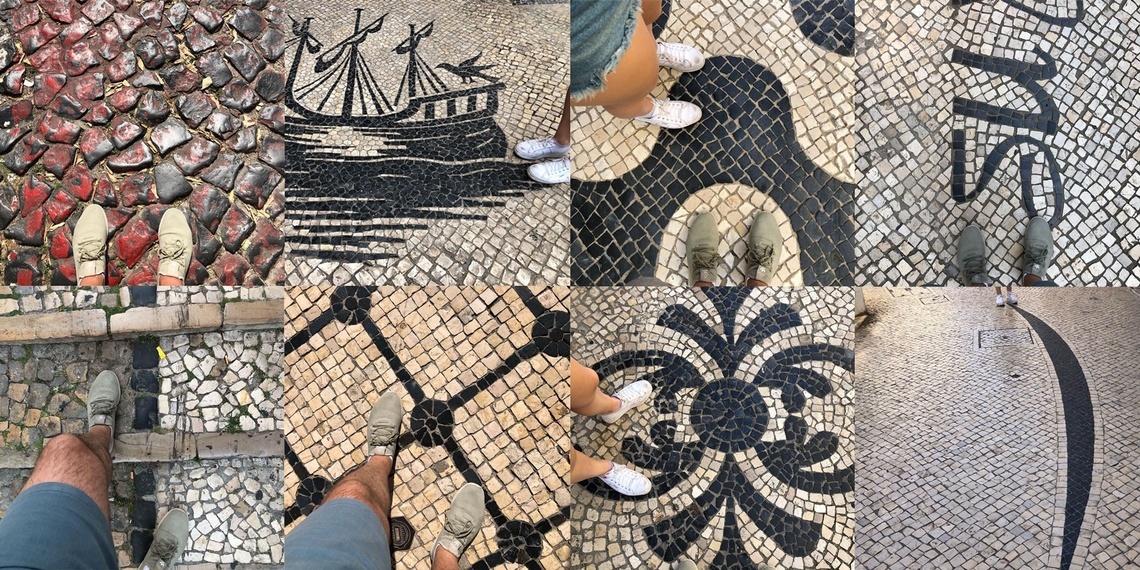When you visit Lisbon, one of the things that usually surprises you the most is its typical sidewalks paved with mosaics of black and white cobblestones.
These stone floors, one of the most emblematic jewels of the Portuguese capital, have become an inescapable attraction for those lucky enough to walk on them.
The Portuguese cobblestone, known as "calçada portuguesa", is an art in itself. Made of irregular stones, usually limestone or basalt, they are meticulously arranged to form intricate decorative patterns and patterns.
This type of paving has its roots in the 15th and 16th centuries, but it was the devastating earthquake of 1755 that marked a turning point in its history. The city was left in ruins and the Portuguese cobblestone technique, due to its complexity and cost, fell into disuse during the arduous stage of reconstruction. However, like a phoenix rising from the ashes, the Portuguese cobblestone found its redemption in the 19th century, specifically in 1842.
The push to revive this ancient tradition was led by Lieutenant General Eusébio Pinheiro Furtado, who led prisoners in paving work under his command as Governor of Arms of São Jorge Castle.
What started as a simple zig-zag path turned into something unusual and revolutionary for the time. Praça do Rossio was one of the first areas to experience the renaissance of this art, and quickly its popularity spread throughout the city and beyond, even conquering the Portuguese colonies.
It is important to recognize the work of the "calceteiros", as the artists and pavers who carry out this meticulous task are known in Portuguese. His dedication and ability to bring intricate designs to life deserved a tribute, and this is how in 2006 a monument to the "calceteiro" was erected in front of the church of San Nicolás, on Rua da Vitória in Lisbon. This monument is an eternal reminder of his talent and contribution to the cultural identity of Lisbon.
Book your stay: Casual Belle Epoque Lisbon .
These stone floors, one of the most emblematic jewels of the Portuguese capital, have become an inescapable attraction for those lucky enough to walk on them.
The Portuguese cobblestone, known as "calçada portuguesa", is an art in itself. Made of irregular stones, usually limestone or basalt, they are meticulously arranged to form intricate decorative patterns and patterns.
This type of paving has its roots in the 15th and 16th centuries, but it was the devastating earthquake of 1755 that marked a turning point in its history. The city was left in ruins and the Portuguese cobblestone technique, due to its complexity and cost, fell into disuse during the arduous stage of reconstruction. However, like a phoenix rising from the ashes, the Portuguese cobblestone found its redemption in the 19th century, specifically in 1842.
The push to revive this ancient tradition was led by Lieutenant General Eusébio Pinheiro Furtado, who led prisoners in paving work under his command as Governor of Arms of São Jorge Castle.
What started as a simple zig-zag path turned into something unusual and revolutionary for the time. Praça do Rossio was one of the first areas to experience the renaissance of this art, and quickly its popularity spread throughout the city and beyond, even conquering the Portuguese colonies.
It is important to recognize the work of the "calceteiros", as the artists and pavers who carry out this meticulous task are known in Portuguese. His dedication and ability to bring intricate designs to life deserved a tribute, and this is how in 2006 a monument to the "calceteiro" was erected in front of the church of San Nicolás, on Rua da Vitória in Lisbon. This monument is an eternal reminder of his talent and contribution to the cultural identity of Lisbon.
Book your stay: Casual Belle Epoque Lisbon .




Comments